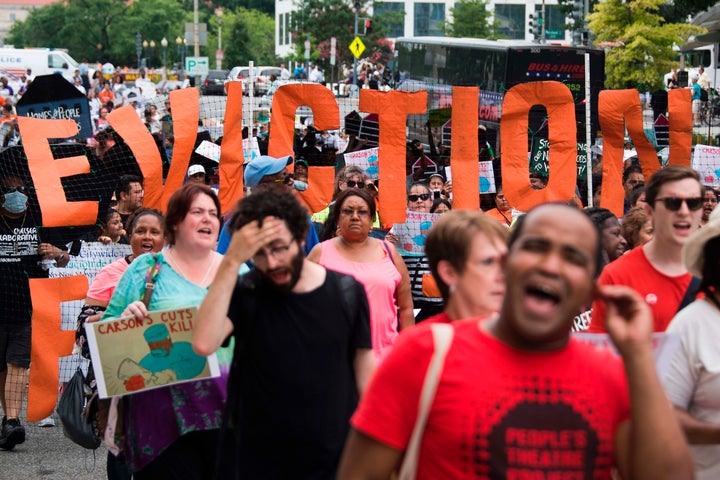President Donald Trump has been on a tear about homelessness over the past week, spreading a lot of misinformation about what the real issue is and how to address it.
Earlier this week Trump lamented the nation’s homelessness crisis ― not because so many Americans are unable to afford safe and stable housing, but rather because it’s supposedly affecting the “prestige” of California cities like Los Angeles and San Francisco.
“In many cases [people] came from other countries and they moved to Los Angeles or they moved to San Francisco because of the prestige of the city, and all of a sudden they have tents. Hundreds and hundreds of tents and people living at the entrance to their office building. And they want to leave,” Trump told reporters Tuesday.
The next day, Trump claimed that San Francisco’s homelessness crisis was creating a “terrible situation” with needles and other trash flowing into the ocean, and that he plans to order the Environmental Protection Agency to cite the city for the pollution.
“They have to clean it up,” he told reporters Wednesday. “We can’t have our cities going to hell.”
Mayor London Breed and an official with the San Francisco Public Utilities Commission both said Thursday that the supposed problem does not exist.
“To be clear, San Francisco has a combined sewer system, one of the best and most effective in the country,” Breed said in a statement to HuffPost. “No debris flow out into the Bay or the Ocean.” Public Utilities Commission spokesman Tyler Gamble told the San Francisco Chronicle: “We haven’t had any (recent) problems with syringes.”
But Trump is not the only one who gets it wrong on homelessness (though he has a responsibility to get it right given the platform and power he holds as U.S. president). Here’s a fact-check on some all-too-common and harmful stereotypes about people who are unhoused:

Fact: Homelessness is a serious problem nationwide.
Affordable housing is a crisis across the country, and more than 500,000 people were homeless in the U.S. on a given night in January 2017, according to the U.S. Department of Housing and Urban Development. While there’s been a decline in the number of homeless Americans over the last decade, last year saw the first increase in recent years, per the HUD report.
California is one of the states with the worst rates of homelessness, and over the past couple years, homelessness has spiked in the San Francisco Bay Area and Los Angeles.
To address the issue, advocates and experts have long called for more government investment in affordable housing and support services for homeless and housing-insecure people.
Myth: Most homeless people live on the streets.
Of the roughly half-million Americans homeless on a single night in 2017, about two-thirds (65%) were living in shelters or transitional housing, while about one-third (35%) were “unsheltered,” or living on the street or in abandoned buildings, according to HUD.
These figures vary by region: In the San Francisco Bay Area in 2017, about 4,350 of 7,500 homeless people were considered “unsheltered” ― or 58%.
Many people who are homeless are also not in shelters or on the street, but living in their cars or “doubled up” at friends’ homes ― situations that can be unsustainable and even unhealthy.
“When you ask someone on the street why they became homeless, no one’s going to say it’s because of decades of federal disinvestment in affordable housing.”
- Shahera Hyatt
Myth: Most homeless people are mentally ill.
About 20% of people who were homeless had a serious mental illness, according to a 2016 U.S. Department of Health and Human Services report. For homeless people living on the streets, those figures tend to be higher. People with mental health issues can be particularly vulnerable to becoming homeless, and once they’re homeless, it can be hard to access care.
“When folks say that people become homeless because of a mental health issue or a substance use issue, I usually like to say, ’People don’t become homeless because of those issues, it’s because we don’t have a system in society to support people having a mental health crisis or a substance use issue,’” Shahera Hyatt, director of the California Homeless Youth Project, said in a conference speech last year.
“Because not all people having those issues experience homelessness,” she added. “It’s the folks living in poverty who often lack the social safety net to buoy them through the storm.”
Myth: Most homeless people are addicts.
About 17% of people who are homeless also suffer from a chronic substance use disorder, according to HHS. Mental health and substance abuse issues can be connected, as people suffering from mental illness who lack access to treatment may try to “self-medicate” with drugs or alcohol.
Myth: Most homeless people on the streets in big cities like LA come from out of state.
It’s a common misconception that people who are homeless around the country move to big cities like Los Angeles or San Francisco because of the better weather or social services.
Democratic California Sen. Dianne Feinstein perpetuated this myth earlier this week, telling a HuffPost reporter that “part of the problem” around homelessness was that “a lot of people come to the state who are homeless.” “People just gravitate,” she said of the Los Angeles area.
A 2018 report from the Los Angeles Homeless Services Authority says otherwise: Only 13% of homeless people in Los Angeles who were “unsheltered” ― or living in the streets or vehicles ― were from out of state. About 75% lived in the county before they became homeless, and 65% had lived in the county for more than 20 years.
Feinstein’s team did not immediately respond to a request for comment.
Myth: It’s their fault they’re homeless.
As the National Alliance to End Homelessness puts it, “The solution to homelessness is simple ― housing.” Yet affordable housing is hard to come by in America. Over the past few decades, housing costs have risen far faster than incomes. And homeless advocates say that governments at the federal, state and local levels have not done enough to make more affordable housing available.
“When you ask someone on the street why they became homeless, no one’s going to say it’s because of decades of federal disinvestment in affordable housing,” Hyatt told HuffPost in 2016. “It’s much easier to look around and see people in the streets as the problem — and not see it’s the broken system.”
People of color in the U.S. also experience homelessness at higher rates than white people do, according to the National Alliance to End Homelessness. Black Americans, for instance, make up more than 40% of homeless people, but only about 13% of the total U.S. population.

